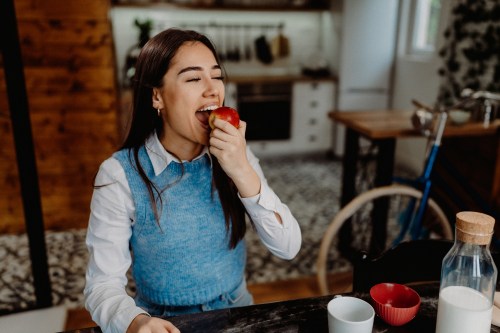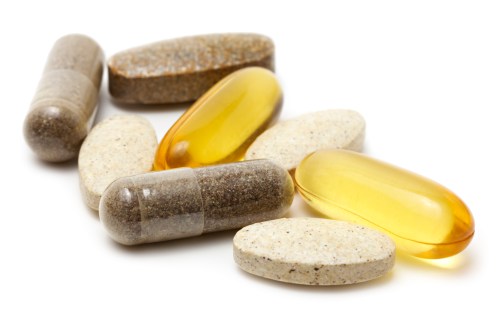It’s fair to assume you have a gluten intolerance (i.e., the inability to properly digest the protein gluten) when you’re left dealing with bloating, gas, and general misery after eating a piece of toast. But there’s another lesser-known food sensitivity to have on your radar—and it could actually be what’s behind your gut symptoms.
Experts in This Article
gastroenterologist in Los Angeles, California
gastroenterologist at MemorialCare Orange Coast Medical Center in Fountain Valley, California
gastroenterologist and associate professor at Rutgers Robert Wood Johnson Medical School.
a registered dietitian and instructor in the school of medicine at Case Western Reserve University
It’s called fructan intolerance (i.e., the inability to properly digest the sugar molecule fructose in certain carbohydrates like fruit, vegetables, and grains) and healthcare providers say most people don’t even know it’s a thing.1 Still, questions are swirling after fructan intolerance came up in a recent viral TikTok from Wendi LeBrett, MD, a gastroenterologist in Los Angeles, California known as @socaldoc on Instagram. In an “I wish more people knew” post, Dr. LeBrett wrote, “Most people aren’t actually intolerant to gluten but instead have a fructan intolerance.”
Like gluten, exposure to fructan can cause digestive issues in people who are sensitive to the carbohydrate. But these intolerances are very different, meaning their treatments are slightly different, too. We tapped two gastroenterologists and a registered dietitian to break it down.
What is fructan intolerance?
Fructan is a type of complex carbohydrate that’s made up of chains of fructose, a form of sugar, explains Lindsay Malone, MS, RD, an instructor in the school of medicine at Case Western Reserve University. “Fructan intolerance is an inability to digest fructans, [which are] found in wheat, onions, garlic, barley, Brussels sprouts, cabbage, broccoli, pistachios, and artichokes,” she says. “It's found in other foods, too, but in high amounts in these foods.”
Fructans can be hard to break down in the gut if you don’t have enough of an enzyme called alpha-galactosidase, says Ashkan Farhadi, MD, a gastroenterologist at MemorialCare Orange Coast Medical Center in Fountain Valley, California.2 (For context: Enzymes speed up the rate of a specific chemical reaction in your cells. In this case, they help break down fructans in the gut.) “If you cannot break fructan down, it will remain undigested in the gut and will reach the colon,” Dr. Farhadi says.
Gas is a big sign of a fructan intolerance, along with symptoms similar to irritable bowel syndrome (IBS)—a condition that causes bouts of stomach pain, diarrhea, or constipation, says Ellen Stein, MD, a gastroenterologist and associate professor at Rutgers Robert Wood Johnson Medical School. That means bloating, diarrhea, and an urgent feeling that you need to poop are on the menu, Dr. Farhadi says. “It’s the exact same symptoms of a gluten sensitivity or lactose intolerance,” he adds.3
A fructan intolerance could also be a sign you’re dealing with another underlying gut health issue, Malone says. “Gut health conditions do tend to run together,” she says. “If you think of the gut like a garden, if there is a problem with the soil, it isn’t isolated to one spot in the garden.” Fructan intolerance can be linked with small intestinal bacterial overgrowth (SIBO), which is an overgrowth of bacteria that colonize in the small intestine, she explains.4
But Dr. Farhadi says that experts don’t usually know why someone will have a fructan intolerance.
Why does it get mistaken for gluten intolerance?
You probably have some baseline familiarity with gluten intolerance, but a recap never hurt anyone. Gluten is a protein found mostly in wheat, barley, and rye. The American Academy of Allergy, Asthma & Immunology (AAAAI) notes that when you have this intolerance, you often experience gas, stomach pain, or diarrhea when you eat gluten. This is not to be confused with celiac disease, says Dr. Farhadi, which is an autoimmune disorder that damages the small intestine when gluten is ingested, per the AAAI.
So, why do gluten and fructan intolerances get confused? One reason is most people are simply more familiar with gluten, so they may just assume that's their issue, says Dr. Farhadi. And seeing that the symptoms closely overlap, this can add to the confusion, he adds. Another reason is that "gluten and fructans are in a lot of the same foods, so it's easy to get confused by the symptoms and not know if one or both of these are your issues,” Malone says.
Making things even more complicated, there aren't great testing options for either condition. Providers will instead suggest elimination diets to mitigate symptoms versus giving a solid diagnosis. Because of that, Dr. Farhadi says it's hard to know for sure how many people truly have a fructan intolerance.
However, research suggests that people with IBS are especially vulnerable to fructan intolerance, with up to 51 percent of IBS cases also having food sensitivity.5
5 ways to treat fructan intolerance
Treatment for a fructan intolerance is tied to its diagnosis. By making small changes to your diet, with the guidance and approval of your healthcare provider, you can determine the type of intolerance you might be dealing with. Here are some tips on how to do that:
1. Go on a low-FODMAP diet
FODMAP is an acronym for fermentable oligosaccharides, disaccharides, monosaccharides, and polyols.6 These are all forms of sugar molecules found in certain fruits, vegetables, legumes, and whole grains. Because FODMAPs are more likely to cause gas and bloating for certain people, a low-FODMAP diet (i.e., an eating plan that limits these foods) is recommended for a fructan intolerance.
“I use the low-FODMAP diet as a test for patients with symptoms,” Dr. Stein says. “This helps them find a series of foods less likely to cause symptoms, and to get healthy foods into their diet that can keep them well.” There are a ton of foods that fall into the low-FODMAP diet, but high-FODMAP foods to avoid include:
- Apples
- Garlic
- Beans
- Asparagus
- Chamomile
- Onion
Need a larger breakdown? Check out our list of things to eat (or not eat) on a low-FODMAP diet.
2. Keep a food diary
Keeping a food diary for a brief time, to track what you eat and how you feel afterward, can be helpful when diagnosing an intolerance. You can keep track of how much of the food you ate and the symptoms you're dealing with, too. Using a tracking app, writing it in your phone's note section, or keeping a physical food journal are all good options. “See if you can pinpoint a food that you’re suspicious about,” Dr. Farhadi says. And then “share this with your doctor.”
3. Reintroduce some foods
Dr. Stein recommends following the low-FODMAP diet for four to six weeks before slowly starting to reintroduce some of these high-FODMAP foods. “We just monitor what happens and how they feel,” she says. “Most patients can tolerate small portions of all the FODMAPs back into their diet without too much trouble. Large portions of any food can cause symptoms, so we try to keep things balanced.”
4. Tamp down on highly processed foods
If gas and bloating are constants for you, Malone recommends tweaking other areas of your diet, too. “Focus on whole, minimally processed foods, since processed foods can have FODMAP-containing additives that aren’t commonly known or recognized,” she says. This also helps remove extra variables like preservatives, colors, and thickening agents, which could also cause gas and bloating, Malone adds.7
Of course, it's okay to eat certain processed foods now and then—it's more about enjoying everything in moderation to help balance things out.
5. Consider taking a probiotic or enzyme
Probiotics help promote healthy bacteria in the gut, which can influence the types of nutrients your body uses, as well as how much gas you produce. While it won’t cure a fructan intolerance, “a probiotic may help in the way of changing the bacteria population in the gut,” Dr. Farhadi says.
Another option is trying an over-the-counter digestive enzyme like Beano (which contains the alpha-galactosidase enzyme) before eating high-FODMAP foods to see if it cuts down on your gas.
Ultimately, experts say that figuring out the best eating pattern for your gut is the best treatment for a fructan intolerance. “This isn't treated, really—it's about finding the balance that works for your body,” Dr. Stein says.
When to see a healthcare provider
There is no standardized test for fructan intolerance, but research suggests that a hydrogen breath test may help properly diagnose you.8 This is a common test administered by your healthcare provider to determine things like lactose intolerance, as it detects the level of hydrogen gas in your breath resulting from poor digestion.
Still, if your gut health is interfering with your ability to go through your day comfortably, it’s time to get checked out. “Gas, bloating, constipation, and diarrhea are not normal,” Malone says. A healthcare provider can give you a full evaluation to see if your symptoms may be caused by fructan intolerance or something completely different—and set you on the path to wellness from there.
- Fedewa, Amy, and Satish S C Rao. “Dietary fructose intolerance, fructan intolerance and FODMAPs.” Current gastroenterology reports vol. 16,1 (2014): 370. doi:10.1007/s11894-013-0370-0 ↩︎
- “Alpha-Galactosidase.” Alpha-Galactosidase - an Overview | ScienceDirect Topics, www.sciencedirect.com/topics/agricultural-and-biological-sciences/alpha-galactosidase. Accessed 8 Apr. 2025.
↩︎ - Roszkowska, Anna et al. “Non-Celiac Gluten Sensitivity: A Review.” Medicina (Kaunas, Lithuania) vol. 55,6 222. 28 May. 2019, doi:10.3390/medicina55060222 ↩︎
- Sia, T., Tanaka, R.O., Mousad, A. et al. Fructose malabsorption and fructan malabsorption are associated in patients with irritable bowel syndrome. BMC Gastroenterol 24, 143 (2024). https://doi.org/10.1186/s12876-024-03230-x ↩︎
- Leelasinjaroen, Pornchai MD1; Patterson, Aliksandra2; Sharma, Amol MD, MS1; Tan, George MD2; Shaffer, Nicole1; Yurechko, Andy2; Rao, Satish MD, PhD, FACG1. Dietary Fructan Intolerance Another Jigsaw in Irritable Bowel Syndrome (IBS) Puzzle: 465. American Journal of Gastroenterology 112():p S245-S246, October 2017. ↩︎
- Bertin, Luisa et al. “The Role of the FODMAP Diet in IBS.” Nutrients vol. 16,3 370. 26 Jan. 2024, doi:10.3390/nu16030370 ↩︎
- Himashree, P, et al. “Food Thickening Agents: Sources, chemistry, Properties and Applications - A Review.” International Journal of Gastronomy and Food Science, vol. 27, Mar. 2022, p. 100468, https://doi.org/10.1016/j.ijgfs.2022.100468.
↩︎ - Sia, Twan et al. “Fructose malabsorption and fructan malabsorption are associated in patients with irritable bowel syndrome.” BMC gastroenterology vol. 24,1 143. 24 Apr. 2024, doi:10.1186/s12876-024-03230-x ↩︎
Sign Up for Our Daily Newsletter
Get all the latest in wellness, trends, food, fitness, beauty, and more delivered right to your inbox.
Got it, you've been added to our email list.









